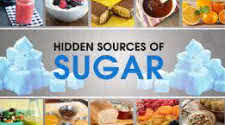Hidden Sugars in Foods - Understanding How Much Sugar is Too Much

Be Smart about your Food Choices
Even if you stay away from jellybeans and table sugar, you may be consuming more sugar than you think. The typical American eats an average of 20 teaspoons every day - that's 320
calories, or 80 grams, of sugar. According to Tufts University Health & Nutrition Letter, this number represents sugar added to food, not naturally occurring sugar you're getting
from fruit, milk, grains and other sources.
The main negative to sugar, as it relates to bodybuilding, are the empty calories. As a carbohydrate, it has four calories per gram, but it's a simple carb with no fiber, no vitamins
or minerals - nothing "redeeming" as far as nutrients go. As such, your calorie budget would generally be better spent on complex carbs, protein and some fat, with the possible
exception of some very specific times, such as right after training.
Before getting into advice for sugar consumption, you may be surprised to know that complex carbs and simple carbs are all comprised of sugar. The differences between carbs come
from how the sugars are strung together. Single molecules of sugar (monosaccharides) are glucose, fructose or galactose. Disaccharides are double molecules of sugar: sucrose,
dextrose, maltose and lactose. Table sugar and other sweeteners are almost 100% simple carbohydrate, either monosaccharides or disaccharides. Polysaccharides are branched chains of
dozens of glucose molecules. These are the complex carbs, often called "starches." Veggies, fruit and grains contain mainly complex carbs; they also contain fiber, vitamins, minerals
and sometimes a certain amount of protein. Because of their composition and structure, it takes your body longer to digest and metabolize these substances than simple carbs.
If sugar doesn't have nutrients your body can use, why is it in so many foods? Energy. Carbs, whether simple or complex, fuel your body. Simple carbs, taken alone, are metabolized
immediately, resulting in a blood sugar "high" and subsequent drop, instead of the enduring and consistent fuel provided by the breakdown of complex carbs.
Refined and processed sugars (simple carbs) - such as table sugar, high-fructose corn syrup, honey, brown sugar and concentrated fruit juice - are what health experts are increasingly
advising people to limit. They're contained in candy, soda, marshmallows, jelly, Popsicles and other obvious sources. How much sugar should you have in a day? The USDA suggests limiting
added sugars (not those naturally occurring in fruit, grain, etc.) to six teaspoons for someone eating 1,600 calories per day; 12 teaspoons for those who consume 2,200 calories; and
18 teaspoons for 2,800 calories. (One teaspoon of sugar equals four grams.) However, the amount of sugar a person should consume really depends on individual metabolic rate and body
composition. Someone well-muscled and in great shape will generally be able to efficiently handle more sugar than an obese person.
So how does our average intake get up to 20 teaspoons daily? Besides obvious sources such as soft drinks and candy, there are many "hidden" sources of sugar that may surprise you. For
example, a packet of Quaker Cinnamon & Spice oat-meal has more sugar than does a serving of Kellogg's Froot Loops. A cup of Kellogg's Smart Start cereal and a cup of Froot Loops have
the same amount. You may think a cup of applesauce is a healthy snack, but one sweetened variety has more sugar than a Hershey's bar.
Bodybuilders have an added sugar source. Shakes and sports bars frequently contain large amounts of sugar. For example, one very popular high-protein bar contains 30 grams of sugar -
that's 7 1/2 teaspoons right there.
Food labels list grams of carbohydrate and sugar. If you want to limit your consumption, try to choose items with lower sugar content. Becoming aware of the grams of sugar on the Nutrition
Facts labels and the sources of sugar on ingredients lists can go a long way toward making healthier choices.